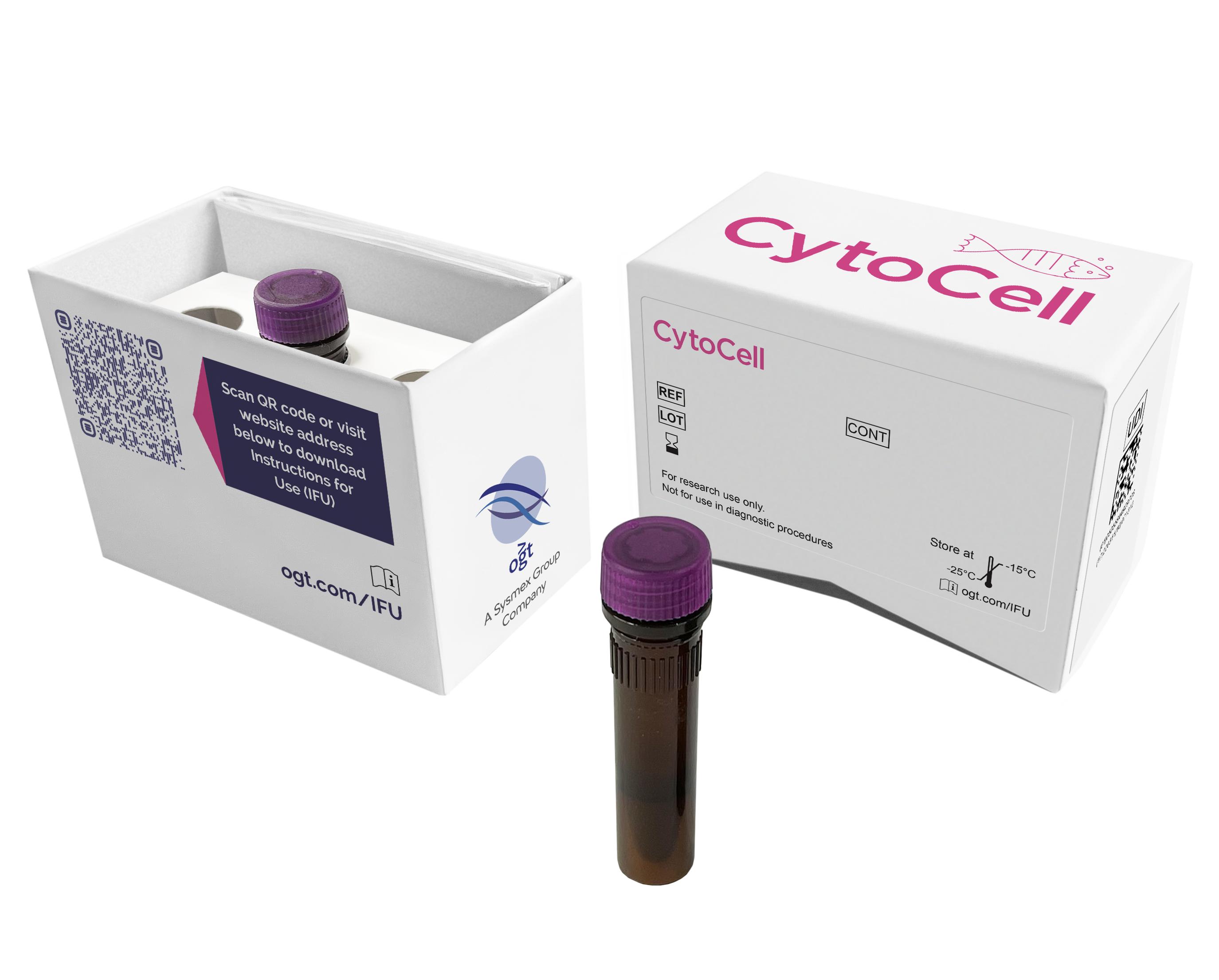
The IGH/FGFR3 product consists of probes, labelled in green, covering the Constant, J, D and Variable segments of the IGH gene, and FGFR3 probes, labelled in red. The FGFR3 probe mix contains a 118kb probe telomeric to FGFR3, including the D4S2561E marker and a second probe covering the 126kb region centromeric to MMSET, including the D4S1182 marker.
The FGFR3 (fibroblast growth factor receptor 3) gene is located at 4p16.3 and IGH (immunoglobulin heavy locus) at 14q32.33.
Approximately 50-60% of multiple myeloma (MM) cases are associated with translocations involving IGH and one of several partners including CCND1, NSD2 (MMSET) and FGFR3, CCND3, MAF or MAFB1.
The t(4;14)(p16.3;q32.3) translocation is a recurrent translocation seen in 15% of MMs2,3.
The translocation results in the dysregulation of two genes at 4p16; NSD2 (nuclear receptor binding SET domain protein 2) and FGFR3. The consequence of the translocation is increased expression of FGFR3 and NSD2. The translocation can be unbalanced, with 25% of cases losing the derivative chromosome 14, associated with the loss of FGFR3 expression2,3.
The majority of the breakpoints on chromosome 4 occur between FGFR3 and NSD2. The breakpoint on chromosome 14 is almost exclusively in the switch region of constant genes. For the overexpression of both FGFR3 and NSD2 the breakpoint on chromosome 14 must be located between the μ enhancer and the 3’ IGH enhancers and between FGFR3 and NSD2. As a consequence, both derivative chromosomes contain an enhancer juxtaposed to an oncogene4.
This t(4;14) translocation is often cytogenetically cryptic and was poorly described before the advent of FISH techniques. The translocation has been associated with poorer survival in MM patients2, 3.
Find certificate of analysis documentation for our CytoCell FISH probes

Our lab has been using a wide range of CytoCell FISH probes for a number of years, and have been increasing this range all the time. The probes have clear bright signals and show good reproducibility. CytoCell provides fast delivery of catalogue probes, and are very responsive when we have any queries or problems with their products.

Bridget Manasse
Addenbrookes Hospital, Cambridge University Hosiptals NHS Foundation Trust, UK
In our hands, CytoCell FISH probes have proven to be of the highest quality with bright, easy to interpret signals, thus providing confidence in our results. OGT's customer support is outstanding, as their staff are extremely knowledgeable and truly care about their customers and their customers’ needs.

Jennie Thurston
Director of Cytogenetics, Carolinas Pathology Group, USA
I first came across CytoCell FISH probes in a previous lab I worked in and I was struck by the quality of the products. Since this time, I have been recommending and introducing CytoCell probes across all application areas — now they are the primary FISH probes used in our lab. They have an excellent range of products and their ready-to-use reagent format saves considerable time.

Elizabeth Benner
Medical Technologist, University of Arizona Health Network, USA
We have been working with CytoCell fish probes for two decades because of their excellent clarity and intensity regardless of the size of the probe. It is so clear and simple to detect.
Dr. Marina Djurisic
Head of Laboratory of Medical Genetics, Mother and Child Health Care Institute of Serbia “Dr Vukan Cupic”, Serbia
The quality and consistency of CytoCell’s probes means I can trust the results, and my clients get their results in a timely manner.

Dr. Theresa C. Brown
Director, Cytogenetics Laboratory, Hayward Genetics Center, Tulane University School of Medicine, USA
It was very important for us to have more consistent results with our probes — easy-to-read bright signals and a range of vial sizes, which is much more cost-effective.

Janet Cowan, PhD
Director of the Cytogenetics Laboratory, Tufts Medical Center, USA
Not only do CytoCell offer an extensive range of high-quality FISH probes, the customer support is also excellent — providing fast access to all the probes I need. The probes are highly consistent with bright signals allowing easy scoring of results.
Dr. Eric Crawford
Senior Director, Genetics Associates Inc., USA
The quality and reproducibility of results using the CytoCell kit has been vital in accurately detecting co-deletions in our glioma investigations. We now have a cost-effective test that we can rely on that is also easy to use and interpret. We've been consistently impressed with this kit - not to mention the support offered by OGT's customer service, and have completely transitioned over to CytoCell probes.
Gavin Cuthbert, FRCPath
Head of Cancer Cytogenetics, Northern Genetics Servce, Newcastle, UK